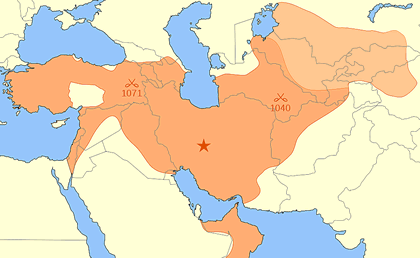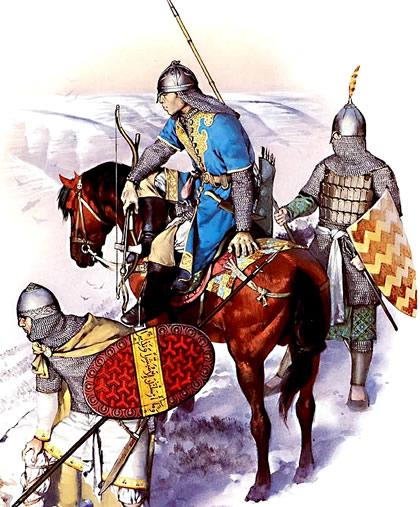World History
In the 10th century Seljuk Turks migrated from territory around the Aral Sea into Transoxiana. Taking their name from Seljuk ibn Yakak, the Seljuks were Turkish nomadic people.
They came to power following the collapse of the Abbasid dynasty when the Fatimid dynasty in Cairo and other ruling families in Spain and North Africa had already established separate ruling dynasties.
Converts to Sunni Islam, the Seljuks based their authority on their military prowess. The Seljuk leader Tughril (d. 1063) crossed into Iran by 1043 and in 1055 entered Baghdad as the new ruling sultan.
Tughril immediately faced revolts by his brothers and Shi’i rebels; after successfully crushing both threats to his authority, Tughril persecuted the Shi’i population and created a Sunni dominated empire. After Tughril’s death, his son, Alp Arslan (r. 1063–73), succeeded to the sultanate.
A military leader, Arslan left the administration of the Seljuk territories to Nizam al-Mulk, who governed from Isfahan. The Seljuk sultanate consisted of a highly decentralized collection of tribal families. At the height of their power the Seljuks ruled territory from the Danube to the Ganges River.
The Seljuks referred to the Byzantine Empire as al-Rum (from Rome). Although Arslan was not interested in actually taking over the Byzantine Empire, he permitted Turkish families to raid and loot Byzantine holdings in Asia Minor as well as into Armenian territory.
Tiring of the Seljuk threats, Emperor Romanos IV Diogenes was determined to confront Arslan. The Byzantine army consisted of Greek soldiers as well as mercenaries from France and the Balkans.
In the ensuing battle the latter proved to be less than loyal to their paymasters. Unbeknown to Romanos IV, Arslan was waiting in Armenia with a large number of well-trained and loyal cavalry forces.
In addition, Arslan’s agents followed the progress of the Byzantines as they crossed the Anatolian Peninsula. The Byzantine forces engaged the Seljuks at the Battle of Manzikert near Lake Van in the summer of 1071.
Large numbers of mercenaries deserted before the battle, which was a disastrous defeat for the Byzantine Empire. The emperor was wounded and taken prisoner by the Seljuks, who then moved in increasing numbers into Asia Minor. Although the Byzantine Empire survived into the 15th century, the Turkish population in Asia Minor would ultimately outnumber the Greeks.
After the Byzantine defeat at Manzikert, western rulers, including the pope, realized that the Byzantine Empire was not strong enough to protect Christians in the east. Seljuk control over the Christian holy sites would be a major contributing factor to the Crusades at the end of the 11th century.
After the Byzantine Empire called on the Seljuks for help against European rivals, they were rewarded with the city of Nicaea (Iznik), which became the capital of the sultanate of Rum. Malik Shah (r. 1073–92) succeeded his father as the Seljuk sultan.
Malik’s name, taken from Persian not Turkish sources, indicated the extent of Persian influences within the Seljuk empire. With the exception of a few coastal cities such as Acre in the eastern Mediterranean, Malik Shah’s territories extended from Syria to Yemen to the Persian Gulf.
With no clear successor Malik Shah’s death marked the end of the unified Seljuk empire, which soon fractured into a number of separate territories ruled by rival factions. The lack of political and military unity was a major factor in the Muslim losses to the crusaders. The last of the Seljuk territories fell to the Ottomans in 1300.
- Irene - Princess Of Hungary
Irene - Princess of Hungary Irene of Constantinople (also referred to as Princess Piroska) was the daughter of King Ladislas of Hungary, who ruled from 1077 c.e. He was the son of Béla I of Hungary and Richeza, princess of Poland. Ladislas astutely...
- Ottoman Empire: 1299–1453
Ottoman Empire In the 13th century a nomadic Turkish tribesman named Ertogrul established control over large parts of northwest Anatolia. The Ottoman Empire took its name from his son Osman (r. 1280–1324); Ottoman was an Italian corruption of Osmanli....
- History Of Iran
History of Iran. This is an essay on the history of Iran which was known as Persia in ancient times. From the site: The ancient nation of Iran, historically known to the West as Persia and once a major empire in its own right, has been overrun frequently...
- The Siege Of Constantinople In 1453
The Siege of Constantinople in 1453 - The fall of Constantinople marked the end of the Byzantine Empire and the beginning of the Ottoman; an online collection of primary sources and articles. From the site: One of the most important events in world history,...
- Byzantine Empire
Byzantine Empire. This is a nice essay on the history of the Eastern Roman Empire. It is from Wikinfo. From the site: The Byzantine Empire or Eastern Roman Empire was the eastern section of the Roman Empire which remained in existence after the...
World History
Seljuk Dynasty
 |
| Seljuk empire map right after the death of Sultan Malik Shah I |
In the 10th century Seljuk Turks migrated from territory around the Aral Sea into Transoxiana. Taking their name from Seljuk ibn Yakak, the Seljuks were Turkish nomadic people.
They came to power following the collapse of the Abbasid dynasty when the Fatimid dynasty in Cairo and other ruling families in Spain and North Africa had already established separate ruling dynasties.
Converts to Sunni Islam, the Seljuks based their authority on their military prowess. The Seljuk leader Tughril (d. 1063) crossed into Iran by 1043 and in 1055 entered Baghdad as the new ruling sultan.
  |   |
Tughril immediately faced revolts by his brothers and Shi’i rebels; after successfully crushing both threats to his authority, Tughril persecuted the Shi’i population and created a Sunni dominated empire. After Tughril’s death, his son, Alp Arslan (r. 1063–73), succeeded to the sultanate.
A military leader, Arslan left the administration of the Seljuk territories to Nizam al-Mulk, who governed from Isfahan. The Seljuk sultanate consisted of a highly decentralized collection of tribal families. At the height of their power the Seljuks ruled territory from the Danube to the Ganges River.
The Seljuks referred to the Byzantine Empire as al-Rum (from Rome). Although Arslan was not interested in actually taking over the Byzantine Empire, he permitted Turkish families to raid and loot Byzantine holdings in Asia Minor as well as into Armenian territory.
 |
| Seljuk soldier |
Tiring of the Seljuk threats, Emperor Romanos IV Diogenes was determined to confront Arslan. The Byzantine army consisted of Greek soldiers as well as mercenaries from France and the Balkans.
In the ensuing battle the latter proved to be less than loyal to their paymasters. Unbeknown to Romanos IV, Arslan was waiting in Armenia with a large number of well-trained and loyal cavalry forces.
In addition, Arslan’s agents followed the progress of the Byzantines as they crossed the Anatolian Peninsula. The Byzantine forces engaged the Seljuks at the Battle of Manzikert near Lake Van in the summer of 1071.
Large numbers of mercenaries deserted before the battle, which was a disastrous defeat for the Byzantine Empire. The emperor was wounded and taken prisoner by the Seljuks, who then moved in increasing numbers into Asia Minor. Although the Byzantine Empire survived into the 15th century, the Turkish population in Asia Minor would ultimately outnumber the Greeks.
After the Byzantine defeat at Manzikert, western rulers, including the pope, realized that the Byzantine Empire was not strong enough to protect Christians in the east. Seljuk control over the Christian holy sites would be a major contributing factor to the Crusades at the end of the 11th century.
After the Byzantine Empire called on the Seljuks for help against European rivals, they were rewarded with the city of Nicaea (Iznik), which became the capital of the sultanate of Rum. Malik Shah (r. 1073–92) succeeded his father as the Seljuk sultan.
Malik’s name, taken from Persian not Turkish sources, indicated the extent of Persian influences within the Seljuk empire. With the exception of a few coastal cities such as Acre in the eastern Mediterranean, Malik Shah’s territories extended from Syria to Yemen to the Persian Gulf.
With no clear successor Malik Shah’s death marked the end of the unified Seljuk empire, which soon fractured into a number of separate territories ruled by rival factions. The lack of political and military unity was a major factor in the Muslim losses to the crusaders. The last of the Seljuk territories fell to the Ottomans in 1300.
- Irene - Princess Of Hungary
Irene - Princess of Hungary Irene of Constantinople (also referred to as Princess Piroska) was the daughter of King Ladislas of Hungary, who ruled from 1077 c.e. He was the son of Béla I of Hungary and Richeza, princess of Poland. Ladislas astutely...
- Ottoman Empire: 1299–1453
Ottoman Empire In the 13th century a nomadic Turkish tribesman named Ertogrul established control over large parts of northwest Anatolia. The Ottoman Empire took its name from his son Osman (r. 1280–1324); Ottoman was an Italian corruption of Osmanli....
- History Of Iran
History of Iran. This is an essay on the history of Iran which was known as Persia in ancient times. From the site: The ancient nation of Iran, historically known to the West as Persia and once a major empire in its own right, has been overrun frequently...
- The Siege Of Constantinople In 1453
The Siege of Constantinople in 1453 - The fall of Constantinople marked the end of the Byzantine Empire and the beginning of the Ottoman; an online collection of primary sources and articles. From the site: One of the most important events in world history,...
- Byzantine Empire
Byzantine Empire. This is a nice essay on the history of the Eastern Roman Empire. It is from Wikinfo. From the site: The Byzantine Empire or Eastern Roman Empire was the eastern section of the Roman Empire which remained in existence after the...
